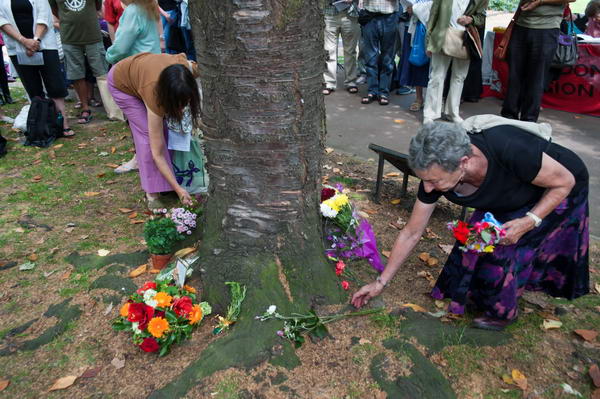At 8.15 am Hiroshima time on 6 August 1945 the bomb called “Little Boy” was released from the B29 named “Enola Gay” after the pilot’s mother and around 45 seconds later its 60 kilograms of uranium-235 detonated around 1900 ft above the city.

Flowers are laid at the cherry tree commemorating Hiroshima in Tavistock Square, 6 Aug 2009
Several years recently I’ve attended the annual memorial event at Tavistock Square in central London, but this year I didn’t make it. You can see a report on last year’s event on My London Diary. I hope to get to the exhibition After the Bomb Dropped: How Hiroshima and Nagasaki Suffered which is now showing at the Friends Meeting House on Euston Road until August 12.
I don’t know which photographs the show will contain. The only photographer known to have photographed in Hiroshima on the day the bomb dropped was Yoshito Matsushige (1913-2005) a 32 year-old photographer for the Chugoku Newspaper in 1945, and you can read his testimony in English online. He was eating breakfast without his shirt on at his home, 2.7 km away from the centre of the blast when them bomb exploded. He saw “the world around me turned bright white.” Then came the blast, which felt like hundreds of needles stabbing into his bare torso, blowing holes in the wall and ceiling, filling the room with dust.
Matsushige pulled his camera and clothes from a mound of dust and went out on the streets. War-time shortages meant he had only two rolls of 120 film for his camera. He soon came on victims, school kids with terrible burn blisters, but though he picked up his camera he couldn’t bear to press the shutter. It took him 20 minutes to get courage to take one shot, then he moved to take a second. He walked all around the central area where the damage was at its worst, finding many terrible scenes, including a bus full of 15-20 naked dead bodies, people whose clothes had been stripped away by the blast that killed them, but was unable to bring himself to take the picture. As a newspaper photographer he also knew that pictures showing corpses could not at that time be published.
In all he managed to force himself to take just a handful of images, seven in all, of which only five came out, so stunned was he by the horror of the scenes he saw. He found himself unable to photograph the screaming and suffering victims face on; he could only make himself photograph them from the back, and even then it was hard to know that he was unable to help them. He reports that there were other photographers in Hiroshima that day, both at his newspaper and army photographers, but none of them were able to take pictures. He is the only photographer known to have photographed Hiroshima that day.
Three days later on August 9 a second bomb was dropped on Nagasaki. Yosuke Yamahata was sent by the Japanese Army News and Information Bureau to photograph the city as soon as the news came through, but transport was so badly disrupted that he was unable to reach it until the following day. He published a book of his pictures, Nagasaki Journey, in 1996 (the review by David L. Jacobs looks more generally at pictures of the dead), and you can also see his pictures and read his testimony at the Exploratorium site.
One thought on “Hiroshima 65 Years On”